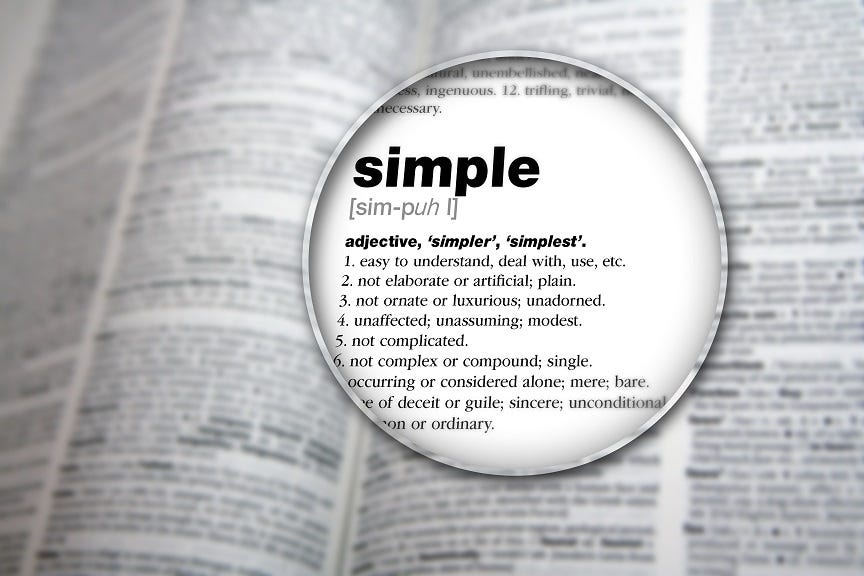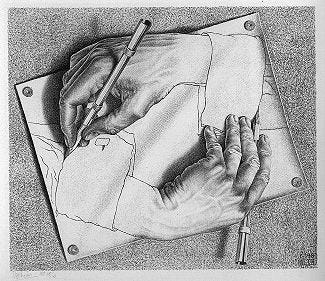Windows, Mirrors, and Lenses: On Intentional Prose
What is writing style? Is it a) an expression of your personality, a mysterious, innate quality, or b) simply a collection of tips and tricks? I have found both framings helpful, but ultimately unsatisfactory. Clear and Simple as The Truth, by Francis-Noël Thomas and Mark Turner, presents a simple, coherent, alternative. The book helps me cohere many loosely connected ideas on writing, and writing styles, in my head.
For Thomas and Turner, a mature writing style is defined by making a principled choice on a small number of nontrivial central issues: truth, presentation, cast, scene, and the intersection of thought & language.
They present 8 writing styles: classic, reflexive, practical, plain, contemplative, romantic, prophetic, and oratorical.
The book argues for what they call the classic style, and teaches you how to write classically. While no doubt useful for many readers, my extended review will take a different approach. Rather than championing one approach, I’ll inhabit each style on its own terms, with greater focus on the more common styles in contemporary writing, before weighing their respective strengths and limitations, particularly when it comes to nonfiction internet writing.

Writing as different screens. Image generated with Google Nano Banana
Classic style: A Clear Window for Seeing Truth
Classic style presents truth through transparent prose. The writer has observed something clearly and shows it to the reader, who is treated as an equal capable of seeing the same truth once properly oriented. The prose itself remains almost invisible, a clear window through which one views the subject. Taken as a whole, a good passage in classic style can be seen as beautiful, but it is a subtle, understated beauty.
At heart, Classic style assumes that truth exists independently and can be perceived clearly by a competent observer. The truth is pure, with an obvious, awestriking quality to itself, above mere mortal men who can only perceive it. The job of the writer is to identify and convey the objective truth, no more and no less.
Prose is a clear window. While the truth the writer wants to show you may be stunning, the writer’s means of showing it is always straightforward, neither bombastic nor underhanded. The writing should be transparent, not calling attention to itself. Unlike a stained glass window, which is ornate but unclear, good classic writing allows you to see the objective truth of the content beyond the writing.
In classic style, writer and reader are equals in a conversation. The writer is presenting observations to someone equally capable of understanding them. The writer and reader are both equal, but elite. They are elite not through genetic endowment nor other accidents of birth, but through focused training and epistemic merit. In Confucian terms, they’re junzi, though focused on cultivation of epistemic rather than relational virtues.
A core component of classic style is clarity through simplicity. Complex ideas should be expressed in the simplest possible terms without sacrificing precision. Difficulty should come from the subject matter, not the expression.
Classic style further assumes that for any thought, there exists an ideal expression that captures it completely and elegantly. The writer’s job is to find it. In classic style, every word counts. There are no wasted phrases, nor dangling metaphors. While skimming classic style is possible, you are always missing important information in doing so. Aristotle’s dictum on story endings – surprising but inevitable – applies recursively to every sentence, paragraph, and passage in classic style.
Finally, in classic style, thought precedes writing. The thinking is always complete before the writing begins. Like a traditional mathematical proof, the prose presents finished thoughts, and hides the process of thinking.

Source: https://www.bobsglass.com/6-common-types-of-glass-for-windows
Classic writing samples
Good versions of classic style appear pretty rare in the internet age. Of all the writers I regularly read, only two writers jump out to me as writing in mostly classic style: Paul Graham and Ted Chiang.
The classic style serves their subjects well. Graham’s natural domain is fairly abstract advice on startups. Much of early-stage startup ethos can be described impolitely as a confidence game, or more neutrally as a reality distortion field, with the founder selling his highly contentious and idiosyncratic vision to funders and early employees as if it were an inevitable truth. In that context, the simplicity, understated beauty, and self-assuredness of classic style fits perfectly.
In contrast, while Chiang isn’t selling you something, many of his science fiction stories strive for a timeless, ethereal quality, sometimes quite literally. In that philosophical context, classic style, with its beautiful yet muted quality, serves the timeless philosophical science fiction of Chiang well.
Among my own writings, the surface level of Open Asteroid Impact is written in classic style. The complete confidence, lack of self-doubt, and an entire website fully “played straight” helps sell the illusion of a Serious Startup completely immune to either critique or self-awareness, and amplifies the inevitability of doom.
Classic style is very much not my natural style. My first serious attempt to write in unironic classic style is in the coda of my recent post on Intellectual Jokes. My coda is not the purest instantiation of classic style, but I think it does the job well enough.
Unfortunately, there are many bastardizations of classic style online, which tries to emulate many of the surface qualities of classic style without paying the dues of a careful attention towards truth and deliberate, yet concealed effort. The “LinkedIn Bro” style of writing, including the “Thought Leadership” and “Tech Guru” variants, is a common such bastardization.
Classic Style in the Age of the Internet
Honestly I think classic style is just a bad fit for the internet. An underrated downside of classic style is that, more than pretty much any common style of writing, doing it well is just insanely high effort. A central tenet of classic style is presentation: the writing should look smooth and effortless. But this effortlessness is almost always a mirage, like an Instagram model who spends three hours in front of a mirror to apply the “just woke up”, au naturel, “no makeup makeup” look.
I don’t think it’s a coincidence that both Chiang and Graham are very unprolific, and both talk about how hard it is to write well, and how many edits they go through.
In contrast, writing fast and churning out a lot of content is central to success as an internet writer, so it behooves would-be internet writers to find a style that works for them that is less demanding on the need for many rounds of revisions.
That said, I think people underrate the value of practicing and thinking in classic style, even if you chose to ultimately discard it, or not write serious posts in that style. Especially if, like me, you find the classic style alien to your normal writing sensibilities. Forcing yourself to write in that way, unironically, and inhabiting the style in its own lights, and especially doing it in a way that doesn’t leave you unsatisfied in the end, is a great way to grow and improve as a writer, and understand the strengths and weaknesses of your own style of writing.
If you want to write more in the classic style, I recommend reading Clear and Simple as The Truth. Thomas and Turner spend more time discussing the classic style than every other style combined, and have exercises. I’ve also heard good things about Steven Pinker’s The Sense of Style.
Plain Style
Plain style is simple and unadorned.
Plain style has no opinion about truth beyond its existence. Truth isn’t beautiful or complex or subjective or hidden. It’s just there. “The meeting is at 3pm.” “Turn left at the light.” “My password is hunter2.” These truths don’t require contemplation.
Plain style doesn’t explain why. It doesn’t justify. It doesn’t persuade. The meeting is at 3pm. That’s all you need to know.
Unlike classic style’s epistemic elitism, plain style is democratic. Everyone can write it. Everyone can read it. Writer and reader are equals, and normal people, not elites. The writer happens to know something the reader doesn’t. The writer wants to communicate it quickly and efficiently.
The central scene in plain style is a congregation of a Society of Friends. Because the truth is obvious, anybody can find it. Children often find it first. They haven’t learned to complicate things.
Plain style is as sparse as possible. It is almost never beautiful. On the occasions when writing in the plain style seems beautiful, the beauty comes not from words but their absence.
The man sits in the corner of the bar. He fidgets with his ring finger. He orders a fifth shot of vodka. He looks away when the bartender pours. He drinks. He fidgets again.
Plain writing samples
Hemingway writes in this style. To a lesser extent, so does Orwell. Much of news journalism is in this style. Among speculative fiction writers I like, I think Suzanne Collins writes the most in this style.
I believe much of internet writing approaches this style, though not quite the extreme level of sparsity as the example above. Unfortunately it’s not a particularly common style among writers I personally enjoy reading. Dan Luu I think comes closest, though in his case the simplicity of prose is counterbalanced by the sheer density of content.
Plain Style in the Age of the Internet
I think this is a strong contender for a barebones style to aim for, if you’re not sure what style to write in! Unlike classic style or reflexive style, the skill floor is fairly low. So as long as you have interesting things to say, presenting them in plain style is perfectly serviceable, unlike one of the more ornate and/or harder to pull off styles.

Source: https://www.fca.gov/required-notices/plain-writing
Top 7 Tips to Write in the Practical Style
- Know your audience. Practical style helps readers accomplish specific tasks efficiently. To do this, the most important rule of writing in the practical style is knowing who you are writing to, what are they trying to accomplish, and catering to your audience appropriately. Nothing is more important than your reader and their goals.
- Know your shit. The second most important rule of writing in the practical style is knowing what you’re talking about. The only way to efficiently communicate useful knowledge to your reader is by actually knowing useful things to communicate. The “central scene” of the practical style is a seasoned master teaching an apprentice something the master knows deeply.
- Learn the mechanics of how people in your audience normally communicate, and emulate it. For presentation, don’t reinvent the wheel stylistically - write in formats your audience already uses.
- Structure your writing explicitly, and in styles that your readers are likely to be familiar with. Use headers, bullet points, listicles.
- Use verbs. Write in simple, imperative sentences. Instead of ‘The system can be configured’ write ‘Configure the system’.
- Test your writing with users. Don’t just theorize about what impacts your writing might have on theoretical readers, actually have beta readers in your intended audience to test your writings with, and ask for explicit user feedback.
- Learn explicitly from people who teach how to write in the practical style. Strunk&White is a common go-to reference. Williams and Colomb are also recommended by experts. You can also learn from online masters.
Practical writing samples
Wikihow is the purest online example. Online guides to getting things done are often in this style. Instruction manuals are also in this style, and to a lesser extent, some academic writings will be in a hybrid of this style and a different style (most frequently reflexive).

Source: https://www.wikihow.com/Write
Practical Style in the Age of the Internet
I think this style has its place when you’re teaching a specific thing, especially if it’s know-how rather than know-that. I don’t have strong opinions on whether it’s underdone or overdone at the current moment.
I suspect some of my past writings should be ported over to practical style, e.g. forecasting and grantmaking lessons. One day!
Reflexive style (or is it self-aware style?)
Epistemic status: Moderately confident
This is a family of styles that Thomas and Turner do not much like, but is very common in academic writing and internet writing, particularly rationalist and EA writing (which is the discursive tradition I’m perhaps the most familiar with). The family of styles (For simplicity I will from now on refer to the entire family of styles as “it”, “the style,” and “this style”, notwithstanding significant heterogeneity in the family of styles) are archetypically very self-referential. Unlike with other styles, you do not forget that the specific reader, and especially the specific writer exists, and you are reading a specific piece of writing with a specific purpose.
Thanks for reading The Linchpin! This post is public so please free to share it.
Pinker (somewhat derisively) calls this style the postmodernist style. Thomas and Turner (somewhat inaccurately) call it the reflexive style. After discussing with friends, reading articles online, and some self-deliberation, I think “self-conscious” or “self-aware” style captures it best.
The tone might be performatively uncertain, anxious, and apologetic. “In my humble opinion”, “It appears that”, “in my reading of the passage,”, “the data weakly suggests”, “while we cannot fully comprehend providence”, “in my personal, limited experience as a privileged [identity-group marker]”, “epistemic status: uncertain.”
While perhaps tiresome to read, the qualifiers have both epistemic and ritualistic benefits. Epistemically, they facilitate reasoning transparency and help the reader understand and grasp the state of current understanding, and how the writer comes to believe what they believe. Ritualistically, they help the reader and writer situate themselves in a pre-established epistemic and social hierarchy for ideas, to help qualify the social positioning of such ideas.
But I worry I’m being too abstract here. Does that make sense? Let me try a different framing: self-aware style often encodes power structures. For example, in the academic variant, graduate students may hedge more than more senior scholars, and assistant and adjunct professors can be more prone to hedging than tenured professors. Women scholars also tend to hedge more than male scholars, though it’s not clear to me how much of this is due to social pressure versus temperament1.
The historical and genealogical view of self-aware styles is also telling. Often, academic-adjacent communities rise up against the self-aware style. For example, early LessWrong and GiveWell tend to be written in simpler, more conversational prose. They see the self-aware style as overwrought, non-parsimonious, and conversational poison. And yet, they eventually settle on their own variants of the self-aware style, just with slightly different types of hedges and tribal markers.
Perhaps most interestingly, different members of the family of self-aware styles express different non-classic notions of truth, whether objective truth or our ability to access it. Science academia’s hedging and reflexivity may convey a notion of truth as provisional, contingent, and falsifiable. Modern humanities academia’s self-awareness may embody truth as subjective, socially constructed, and mediated by power. Rationalist hedging may encode truth as probabilistic, uncertain, and limited by cognitive biases (72% certain). And in all three, truth is seen as primarily collaborative and interpreted in light of our theories and models, rather than directly observed and presented.
Self-aware styles may see other styles on this list, including classic style, as naive, arrogant, and lacking in self-awareness. In contrast, the other styles may see self-aware styles as confusing, overly self-obsessed, and annoying to wade through.

MC Escher, Drawing Hands
Reflexive writing samples
I think my “The Motivated Reasoning Critique of Effective Altruism” article is a perfect example of writing in this genre. Much of LessWrong and the EA Forum is written in this way. If you want more examples, much of academic writing is in this vein, especially in the humanities and non-econ, non-psychology, social sciences.
Reflexive Style in the Age of the Internet
My biggest reflection from writing this piece is that reflexive/self-aware style is overdone in the internet era, especially in the “smart parts” of the internet. There are many good and bad reasons for this, including genealogical reasons, defensive writing being necessary in the context of aggressive quote-tweeting culture, and speed-reading and reasoning transparency being at a premium in an adversarial epistemic culture. But in my opinion a big reason is just what Paul Graham calls “scar tissue” – every little critique or self-critique nudges the writing culture to be a little more defensive, and a little more self-aware.
One contentious point I have: Self-aware style sees itself as humble, epistemically modest. And in some sense this is surely true. But in another, just as important sense, I think of the self-aware style’s central conceit as very arrogant, especially in the internet era. After all, the single most conceited thing an internet writer can regularly do is hit “publish” on their own thoughts. And by having your discursive tendencies, uncertainty, and self-doubts “on air,” you’re implicitly saying that not only are your factual analyses and insights important enough to be read by dozens, thousands, or millions of people, but your neuroses are as well.
But even with all my reflections and criticisms aside, I still considered the self-aware style and derivatives to be an important part of modern intellectual internet writing, and I expect a nontrivial number of my future pieces to still primarily be in this style.
If you want to write well in a self-aware style without going overboard, I recommend reading Luke on Reasoning Transparency. Many style guides on academic writing can also be helpful here.
Styles for Special Occasions
The remaining styles are less frequent in internet writing, especially in “pure” form. I will be briefer in both my inhabitation of these styles, and in the follow-up discussion.
Contemplative style: Writing as Lens
What do I think about when I think about writing? I often wonder this to myself. But first, what is writing? What is the essence of it, the ur-, Platonic form? Is it a conversation between equals, like in classic style? Is it dispassionate and efficient information transfer, in plain style? Or is there no platonic form at all, just different modes for different times, whatever is most practically relevant? Or is writing an apology for my own positionality and biases? Who’s to say? I find these thoughts hard to think about. And even though I pride myself on my cognitive capacities, I’ve found it hard to turn my thoughts inwards, like a lens that looks too deeply at itself. What does it mean to write? To think? I often find excogitating on the page easier than genuine introspection, and today, alas, is no exception.
The core of contemplative style is thought in action. The archetypal writing in this style has two components: a presentation of an object or event under study, and then a meditative reflection of what the event means to the writer. The archetypal scene of a contemplative style is a solitary thinker in his diary, or on a walk. The presentation component can be done classically, plainly, or practically, but in contemplative style, that’s not what matters. Rather, reflection is the better half: the writer is working through his thoughts, and wants to showcase them to the reader.
This style has found surprising, if niche, success online, particularly in newsletter culture where readers subscribe specifically for a writer’s thought process. Annie Dillard and Maria Popova often write in this style. To a lesser extent, Ada Palmer and Scott Alexander often use elements of this style, with an objective description/summary of something first and then a reflective analysis, though the analysis tends to be more outwardly focused.2 See Gupta on Enlightenment for a more traditional example, and My Heart of Hearts for a less traditional one. Finally, the more cerebral book reviews are often partially in this style.
Romantic Style: Writing as Ornate Mirror
Sometimes I hate writing. I hate, hate, hate it! I hate how difficult it can be. I hate the blank page. I hate how much I identify with my own words, and how much I try and fail to be dispassionate. I hate how tough it is to get a clear thought across on the page. I hate the problem of other minds, and the related problem of true understanding. I hate the clickbaitiness, the artifice, the strong self-driven need to say something original counterbalanced by external pressures to perform. I hate how increasingly good the AIs are at writing, and one day – maybe one day soon – they’ll completely supersede me.
I love writing! I love love love it! I love it as an expression of my soul. I love it as a conduit across the world, and across time. I love writing to subscribers in India, and haters in New Zealand. I love the references, the quotes, the craft, the meta-cognition, the sheer beauty of this art that I share with the great rhetoricians of the past and future. I love how I see myself in Nanni’s customer service complaints about Ea-nāṣir, and perhaps one day my distant digital great-grandchildren could see themselves through my substack notes and preserved screenshots of my embarrassing DMs. I love the cliches, the dance, the tangled world-webs we weave. I love how writing allowed a young Chinese boy in a foreign land to find his voice, and navigate a ferociously confusing external era and internal world. I love writing. Every line is a love letter to my younger and older selves, and perhaps to you.
The romantic style is emotional, raw, unfiltered. Unlike classic style’s conception of writing as a window, or contemplative style self-conception as a lens that sometimes can be turned on itself, the romantic style is always a mirror. It sees styles like the classic and plain styles as sterile, emotionless, and ultimately false in that they ignore the deeper emotional reality for a less interesting external world. It sees the contemplative style likewise as too much brain and insufficient heart. Romantic style is the Humean notion “reason is a slave of the passions” in art form. Romantic style writing is never about “The Truth”, but always your truth.
I don’t personally read much prose in romantic style these days, but I like older and modern poetry in this style, of which my favorite might be Sylvia Plath’s work, particularly Mad Girl’s Love Song. An interesting example of ”antiromantic” style might be Sam Kriss, which takes on romantic style’s subjectivity and emotional tenor, but the primary emotion he chooses to evoke in an audience isn’t “pure” emotions like love, honor, pride, or even hatred and despair, but disgust.
Prophetic Style: The Truth that Burns
What is writing? Thou asked, and I shall answer. Writing, the Muses tell me, is about the Good and the Real. Every Prophet hears the Gods in different ways. Whether it’s Biblical hermeneutics, racial consciousness, omens, portent dreams, direct lived experience, or careful expected utility calculations, when Good and Real speak to you in clarion calls, you must listen. And you must repeat their calls.
The Truth is not transparent, not provisional, not personal. It is urgent, moral, and inescapable.
When you speak The Truth, it bursts through the text in whitehot flames, incandescent, burning with ease through lies, tired excuses, and mere practicality. The Prophecy is not beautiful in the classic sense; it is awful, in the Old meaning of the word: it inspires awe, fear, and sometimes repentance. Your sentences are not crafted to be elegant; they are forged to be unignorable.
Prophecies are largely not crafted to be epistemic, reflective, or practical. To the extent they serve a directly useful purpose, it’s usually as a coordination mechanism. Most interestingly, the prophetic style and the previous styles discussed diverges in the external ensemble. While every other style has some important gradation of writer vs reader (eg readers and writers are equals in classic and plain style, reader is elevated in practical style, writer is elevated in contemplative and romantic style), the most important party in the Prophetic style is an external party to both writer and reader: God(s), Ethnic Consciousness, or Utility.
Modern day examples of true prophetic style are relatively rare. Outside of religious examples, I mostly see them in essays and rap songs about racial consciousness, of which recent examples include works of Ta-Nehisi Coates and Kendrick Lamar. Meditations on Moloch by Scott Alexander is also significantly in this style, as are some entreaties against factory farming. (When I asked for examples of modern prophetic-style writings, people often hallucinate AI “doomer” content as prophetic, but if you drill down into the specific style, I’ve yet to find AI risk articles actually written in this way. Comment if you have examples!).

Prophet Lamar, from https://y105music.com/kendrick-lamars-damn-album-double-platinum/
Oratorical style: Subscribe Now, Friends and Countrymen!
Friends, Romans, countrymen, wanderers of the word-hungry web—lend me your scroll-weary eyes! Before you flit away on the algorithmic winds, pause, I beseech you, at this humble crossroads, to take a stand! Each day you brave fire-hoses of hot takes and half-truths, utter nonsense masquerading as insight and wisdom! Pause for a second. Take a deep breath. Breathe again, and do the right thing! Subscribe to The Linchpin! Learn to write well, think well, and be well!
Your country needs you. Seize the day! Subscribe today!
[subscribe button]
The oratorical style thrives on performance and persuasion, treating prose as a stage where writer becomes speaker, addressing an audience that must be moved to action. It’s unabashedly theatrical, wielding rhythm, repetition, and rhetorical flourishes as weapons of mass conviction. Works in oratorical style, even when written, are meant to be read and heard out loud. Where classic style hides its effort, oratorical style revels in it. The sweat on the speaker’s brow is part of the show.
I’m personally not aware of modern internet writings written primarily in oratorical style, at least in the corners of the internet I frequent.
Finding Your Voice in the Cacophony
Inhabiting each style has been a difficult but enlightening experience. I will gladly do so again. I’ve learned a lot about each writing styles’ strengths and limitations, as well as that of my native styles.
My number one advice for readers interested in elevating their internet writing craft is to not think of style as a single thing to master, or about finding a singular good fit for your personality. Instead, experiment, as I did, with different styles, so you can more deeply appreciate their strengths and limitations.
In the context of the internet, I think we can learn a lot from almost all of these styles. From classic style, we can learn the value of conveying clarity, timelessness, and inevitability in prose form. From plain style, we can learn the value of facts and simplicity. From practical style, we can learn the value of extreme audience awareness and elevating the reader above the writer. From contemplative style, we can learn the value of demarcating a clean separation between reporting on objective reality and discussing our subjective reflections. And so forth.
Ultimately, contra Thomas and Turner, I believe it is a good practice for you to let your content and message drive your style of writing. Rather than developing a specific “personal style”, you may find it helpful to develop several styles that’s a good fit for you, and decide between them for the stories and essays you want to write.
If you want to convey a clear, timeless, and inevitable idea, go with classic style or one of its derivatives. If you just want to share simple facts, plain style is a great choice. If you want to provide useful instructions for your reader, and minimize accompanying discussions, go with practical style. And if you’re genuinely uncertain, and want to present a truth that’s provisional, probabilistic, and tentative, you may want to choose a variant of the reflexive style.
But when you do sit down to write a specific article: commit to something. Strive to aim for stylistic coherence and consistency. Style isn’t just about surface features like spelling or vocabulary choices, or even the broader vibe. Style is about making a principled choice on the key issues – truth, presentation, cast, scene, and the intersection of thought & language – and maintaining it throughout your article. I think you should stick to that.
Unless, of course, the essay demands otherwise. All writing rules are ultimately guidelines, and the best writers know when to break them.
In a future (hopefully shorter) post, I might discuss internet essayists I respect the most. I’d like to cover internet-fluent writers, who are able to mix and match from the above styles to deliver a consistent experience that’s a great fit for the current age. Especially Scott Alexander, a master of the craft whose writing style has spanned a number of competitor styles, perhaps including my own. I’m also interested in covering internet-native writers, whose writing styles are only possible on the modern internet, like multimedia microsite essay style, the wiki-garden style, the tweetstorm style, and so forth.
In the meantime, experiment! Try out different writing styles, wear them like hats, don’t take yourself too seriously but maintain a quiet consistency throughout your work. The worst internet writing isn’t badly styled. It’s unstyled, a gray paste of half-absorbed conventions and unconscious mimicry. So write with coherence and meaning, and don’t be afraid of trying new things.
And if you haven’t already done so, most importantly, please go to the link below and like and subscribe: